
It has been a long haul but we are finally here, friends. This is the 8th and final installment of my series providing analysis of each division, team-by-team, position-by-position. Now we just need the rookies to arrive and mess everything up! Am I right?
It is now time to unearth the opportunities aplenty for us as dynasty gamers in the NFC West.
Let’s get after it!
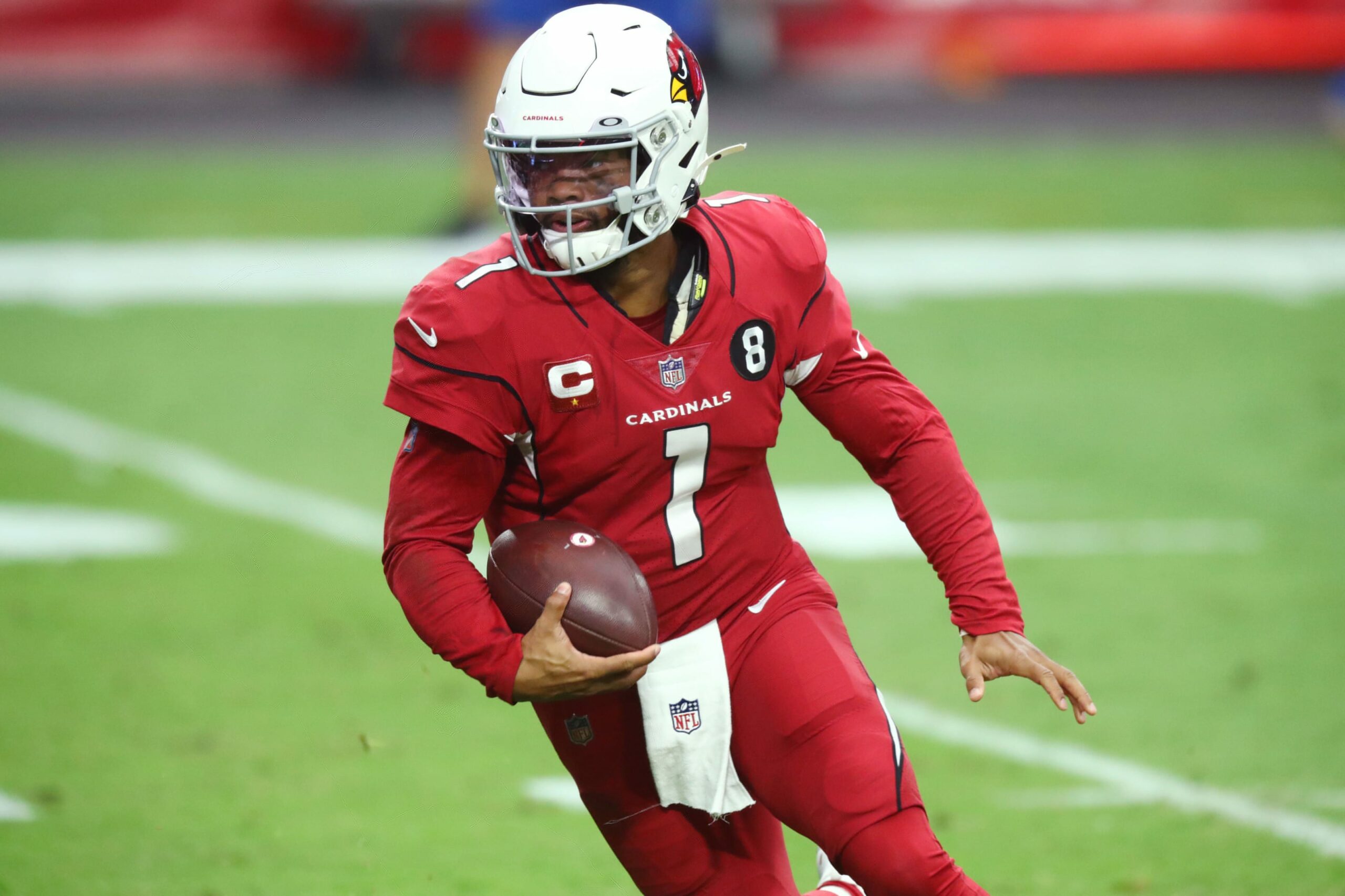
Arizona Cardinals
2020 brought with it the second season of the Kyler Murray-Kliff Kingsbury era. Kingsbury’s uptempo-spread-it-out offense was supposed to be fun, but after two years it’s been a little bit of a letdown. The Cards finished No. 13 in points and No. 6 in yards as they achieved an appropriate 8-8 record. I, for one, am over the Kingsbury era.
The off-season has seen a slight shake-up as Larry Fitzgerald seems to be riding off into the sunset, although it isn’t official yet, and Kenyan Drake went to Las Vegas to muddy the waters in that backfield.
Quarterback
Murray has not disappointed as a runner in his two years in Arizona. Truthfully, this is where his great value lies. Any passing production and efficiency is simply a bonus when you have a guy who can run like Murray. His rushing line of 133/819/11 alone makes him a no-brainer for fantasy purposes. Helpfully though, Murray has shown himself to be an adequate passer and finished in the top half of the league with 3,971 (No. 13 among qualified quarterbacks) passing yards and 26 (No. 12) passing touchdowns. This isn’t a tough call. Murray will be a studly Konami Code QB for years to come.
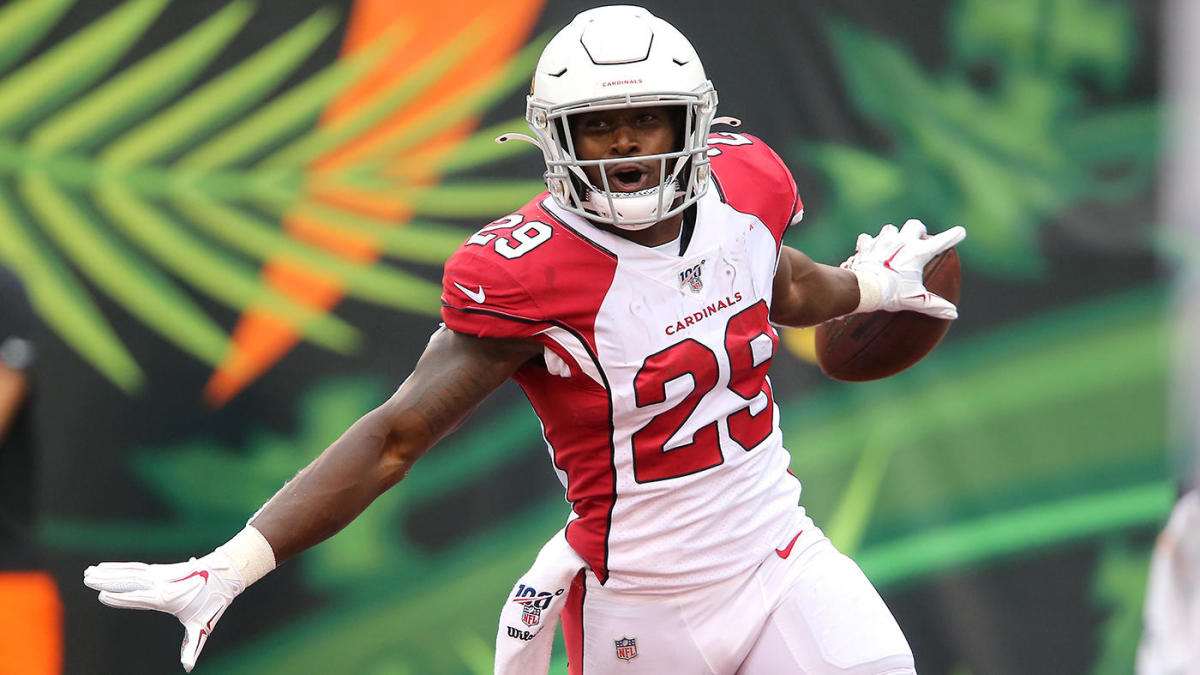
Running Back
With Kenyan Drake‘s departure, Chase Edmonds has a chance to take the reins in Arizona with only James Conner and Eno Benjamin standing in his way, assuming there isn’t an incoming rookie. The problem is that Edmonds just doesn’t seem to have the profile to suggest that he can manage a full workload. Standing at just 5-9 and 205-pounds, he looks the part of a satellite back in the vein of his Best Comparable Player: Dion Lewis. And the addition of Conner, who admittedly isn’t that great of a threat, seems to suggest that the Cards know this.
Will Arizona draft any competition for Chase Edmonds? 🚀 pic.twitter.com/B508UBlnho
— RotoUnderworld (@rotounderworld) April 11, 2021
However, just because Edmonds won’t receive a bellcow workload doesn’t mean that he’s worthless, we just need to temper our expectations and excitement. What he has going for him is a solid receiving skillset. He recorded top 10 marks with 68 (No. 6) targets, 53 (No. 7) receptions and 402 (No. 6) receiving yards, aided by logging 40 (No. 3) slot snaps. I wouldn’t expect his participation in the receiving game to diminish.
The concerning side of his game is his lack of elusiveness. He just didn’t make people miss in 2020, evidenced by his 16.0-percent (No. 52) Juke Rate and 0.91 (No. 50) Yards Created Per Touch. Edmonds also is a non-factor in the red zone, garnering only one (No. 67) goal line carry.
Dynasty Buys: Chase Edmonds and Bryan Edwards are Criminally Undervalued
➡️ https://t.co/rYudTDFGyO pic.twitter.com/JvZKTlFMWQ
— RotoUnderworld (@rotounderworld) April 25, 2021
Edmonds presents owners with a tricky situation. While 2021 may offer the best chance for him to produce, that upside will always be capped by his limited profile. I would wait for a spike in value, which would come due to a Conner injury or the Cards not taking anyone in the draft, and cash in on Edmonds. You can always try to ride it out, but be careful since he’s no lock to be in Arizona in 2022. As someone who scooped up Edmonds in every rookie draft years ago, I hate to hear my own advice, but he is who he is.
I wrote about Connor while he was still a Steeler and this situation isn’t any better. He can safely be ignored since staying healthy seems to be a stretch for him, and even when healthy he isn’t amazing, making Benjamin an interesting stash since he’s basically free.

Wide Receiver
DeAndre Hopkins flourished in his first season in Arizona. He will be 29 years old at the start of the season which is notable. Even so, he draws so many targets and is good enough at football that I wouldn’t mind riding him until he fell off the cliff, whenever that comes around. Obviously, if you can get a great haul for him, do it. But at age 29, buyers may be gun-shy. This is definitely a situation to handle case by case.
A.J. Green‘s arrival is no cause for concern or celebration depending on who you own. He’s washed, it’s sad to say. That leaves Christian Kirk as the de facto WR2 behind Hopkins. Entering into Year 4, Kirk has been good, not great, failing to live up to expectations. Fitzgerald kept Kirk in check for the first two years and Hopkins halted the Year 3 blow-up. And so we are starting to get into truther status on Kirk. Many have probably written him off, but is there still hope?

2020 was nothing short of a nightmare for Kirk and his fantasy owners. There just isn’t much to cause excitement in the metrics. Maybe we can latch onto his 14 (No. 18) red zone targets. I guess that at least tells us that Kyler Murray trusts him in close, and he did end with six (No. 24) receiving touchdowns, the same amount as Hopkins. Unfortunately, he doesn’t pop anywhere else. A middle-of-the-road +6.8-percent (No. 38) Target Premium and below average -1.9 (No. 53) Production Premium makes me wonder if the Cards would be better off with Andy Isabella seeing those targets.
The final issue for Kirk beyond a lack of productivity and efficiency is Murray himself. I’m not convinced that he can support another meaningful receiver with Hopkins drawing so much of the attention. Throw in his rushing prowess and the entire passing game’s ceiling is capped. I hate to say it, but I think it’s time to cut our losses and move on, especially if Kirk is just a low-volume slot receiver.

Tight End
The Cardinals have a tight end on the roster? It’s Maxx Williams? Huh.
Recap: Until further notice, Kyler Murray and DeAndre Hopkins are the only trust-worthy contributors. Chse Edmonds and Christian Kirk are who they are; don’t be a bag-holder.
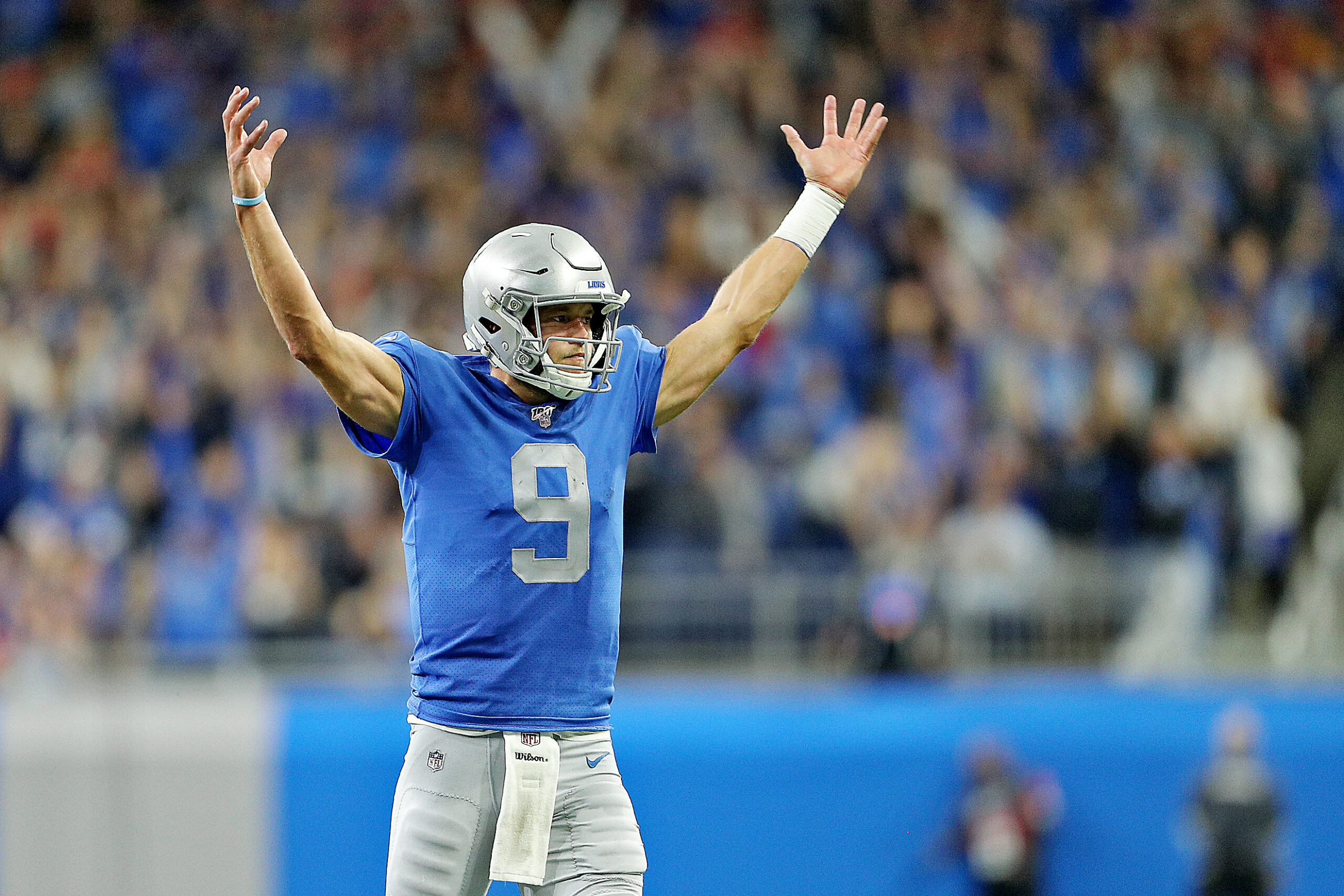
Los Angeles Rams
The Rams 2020 season was a bizarre shift. The offense that was so dominant over the previous three seasons fell apart as they finished No. 22 in points. The defense, meanwhile, finished No. 1 in points allowed. It finally resulted in Jared Goff’s marooning to Detroit. With Matthew Stafford in town, there is at least the hope of an offense that can complement the dominance displayed by their defense. We’ll see about that.
Quarterback
Matthew Stafford is allegedly an upgrade from Jared Goff. Fine. But is he that much better? I’m not so sure.
Entering into his age 33 season, Stafford will be blessed with a better talent group than he had in Detroit last year. Without Kenny Golladay for most of the season, Stafford suffered through 84 (No. 5) dropped passes, which is unfortunate because he was fairly accurate last year, sporting a 7.5 (No. 11) Accuracy Rating. And it’s not like he was just dumping the ball off either. Stafford consistently pushed the ball downfield, averaging 8.6 (No. 4) Air Yards Per Attempt.
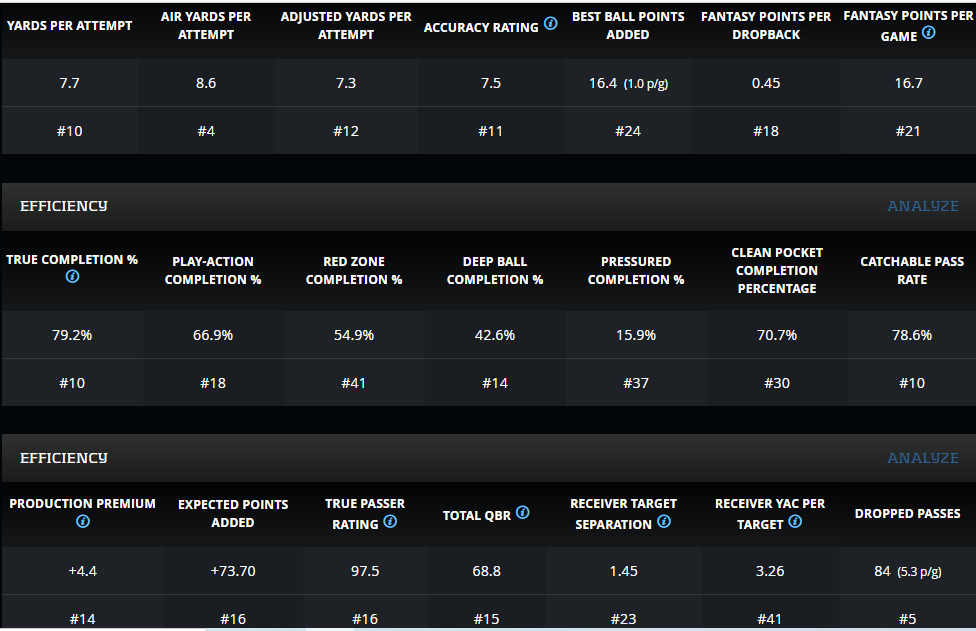
One main concern is how Stafford’s style will fit with the Rams offense. Stafford will be going from Golladay and Marvin Jones, who thrive down the field, to Robert Woods and Cooper Kupp, who operate in the short and intermediate areas of the field. He was also a bit reckless in 2020, notching 36 (No. 6) Danger Plays and 30 (No. 2) Interceptable Passes without much payoff, only ending with 14 (No. 20) Money Throws. Finally, Stafford has no rushing floor. Altogether, we have a slight upgrade for the Rams, a fairly sizable upgrade for Stafford, and a recipe for a QB2 in fantasy. He is who he is at this point, but you could do worse in the late rounds.

Running Back
Sean McVay was just torturing Cam Akers owners last season. He insisted upon giving Malcolm Brown meaningful work and over the course of the season gave Darrell Henderson and Akers an equal share of work. As someone who ended up with more Akers than any other rookie runner, it was frustrating to say the least. However, from Week 13 through the playoffs, Akers started to pull away leaving Brown and Henderson in the dust. And so heading into 2021 it’s all about Cam the Ram.
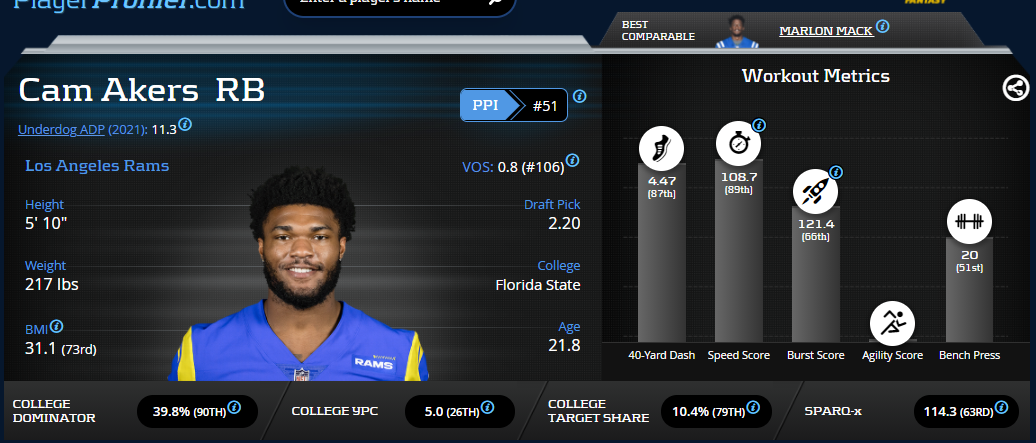
Akers was brilliant coming out of Florida State despite suffering through the worst offensive line in CFB history (No exaggeration). He looks the part of an NFL bellcow, and was on track to take and keep the job Week 1, but unfortunately suffered a rib injury in Week 2, putting the parade on hold. Fortunately, he got healthy and worked his way back to the top of the depth chart, punctuating the point with a Week 14 extravaganza. He dropped 194 yards on 31 touches on the Patriots, leaving no doubt that he’s the guy in Los Angeles. He achieved such success despite facing 7.3 (No. 5) Average Defenders in the Box this season, giving hope that with Stafford keeping defenses more honest that Akers could run wild in 2021.
One area where we need to see improvement is passing game involvement. On the year, Akers only pulled in 11 (No. 74) receptions, although eight came in the final four games. Ultimately, I’m not terribly concerned though, since Akers did post a 10.4-percent (79th-percentile) College Target Share.
Overall, Akers is here to stay and any improvement in the offense for the Rams is a huge boon for Akers’ stock. He’s someone absolutely worth overpaying for in dynasty.

Wide Receiver
The Rams added DeSean Jackson to mix this off-season giving Stafford a deep target but he’s dust. Van Jefferson was hilariously drafted in the second round, but really it’s a two-headed monster in LA.
Cooper Kupp has established himself as a slot monster. He will always have value in PPR leagues, especially since he vacuums up targets close to the line of scrimmage. He pulled in 92 (No. 9) receptions and utilized his 10.83 (92nd-percentile) Agility Score to rack up an astounding 507 (No. 3) yards after catch, which accounted for more than half of his total receiving yards. He’s never been a high YPR guy but 10.5 (No. 88) yards per reception and 6.6 (No. 103) Average Target Distance is simply laughable. His usage and efficiency just aren’t all that interesting leading to a safe floor with a low ceiling.
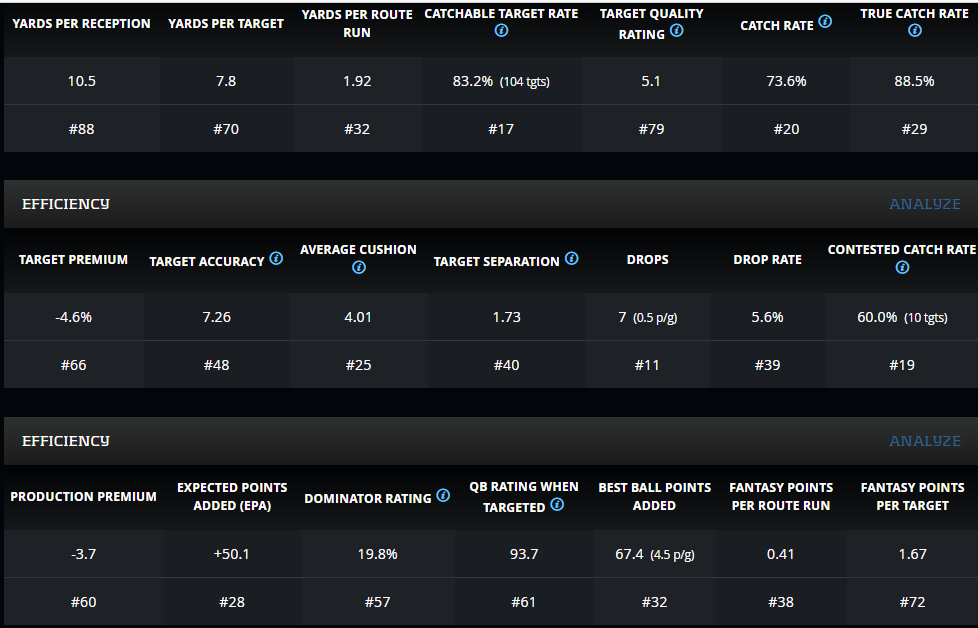
The bullish outlook for Kupp is that Stafford opens up the offense, pushing the ball downfield a bit more and gets him back towards his 2019 efficiency where he went off for 94/1161/10. This could certainly be the case and Kupp is still an excellent YAC receiver. The worry is that Kupp is 28 years old and Stafford may pass over him in favor of deeper targets. Look, he’s still going to feast in the short game, but he might have already peaked.
Robert Woods, meanwhile, was essentially a mirror image of Kupp in 2020. He also operated close to the LOS with only a 7.1 (No. 99) Average Target Distance, leading to a paltry 9.4 (N0. 91) yards per reception. Similar to Kupp, he ate with 487 (No. 4) yards after catch, which accounted for over half of his total receiving yards,, and he’ll be entering his age 29 season. Are they just the same player?

Like Kupp, we have to hope that Woods benefits from Stafford’s style. For both players, the volume should be there since there’s little excitement elsewhere on the roster. Both are reliable receivers and should be in the WR2-3 range. Yet, as both are creeping towards the backside of their careers, it’s hard to get overly excited about them. I’d probably ride them out for 2021 since the production shouldn’t drop off yet, but it’s time to start anticipating a changing of the guard in Los Angeles.

Tight End
Tyler Higbee successfully staved off Gerald Everett, who is in Seattle now, and looks to have the position group locked up for 2021. He, like Woods and Kupp, are just hoping that Stafford brings improvement. Higbee made the most of his looks, ending with a +25.9-percent (No. 2) Target Premium and +18.1 (No. 4) Production Premium, but the looks were sparse and he ended with a 19.0-percent (No. 78) Target Rate. He will need far more targets if he is going to be fantasy-relevant in 2021. If you’re into Stafford, you might as well kick the tires on Higbee. I’m rather ambivalent though, so I’m happy to look elsewhere for my tight end production.
Recap: Cam Akers is a stud. The rest of the offense hinges on Matthew Stafford. He’ll be decent, but it’s hard to see great upside here. Temper your expectations, and don’t be afraid to move on from this aging passing attack.

San Francisco 49ers
The 49ers suffered through some rough injuries losing Jimmy Garoppolo and George Kittle as they went from Super Bowl contenders to 6-10 and looking for a new face of the franchise. There are some fun pieces on this offense, but a whole lot of uncertainty as we approach the draft. As much as any team, we need to pay close attention to how things shake up for the Niners moving forward.
Quarterback
By all accounts, it looks like Mac Jones will be selected at 1.03. Now, whether or not that means he will start right away is another matter. And so for the time being we will treat Jimmy G as if he’s the starter.
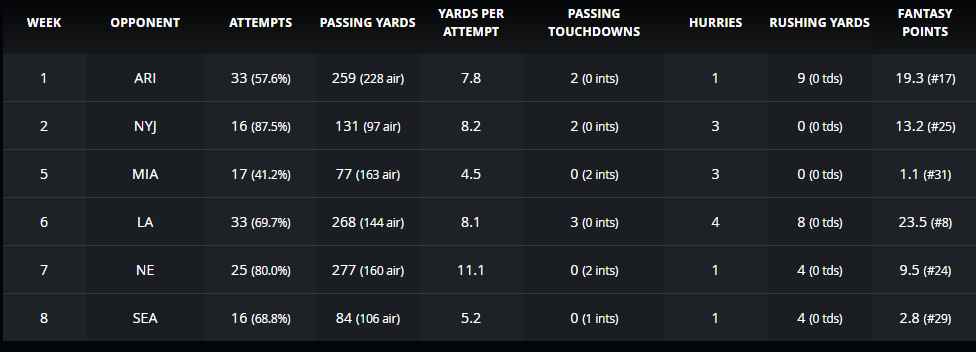
Garappolo managed to play six games as he suffered a high ankle sprain which cut his season short. Even so, the six game sample left much to be desired. To best evaluate him, we need to look at how he performed in 2019.
Jimmy G’s 2019 campaign doesn’t give us much enthusiasm to be quite honest; he was fine. He was reckless with the ball, with 43 (No. 7) Danger Plays and 28 (No. 7) Interceptable Passes. And while his accuracy was good, as seen in a 76.7 (No. 3) True Completion Percentage, the Niners skewed so run heavy as to limit his upside. There also is no rushing floor, making him a risky passer who doesn’t have enough volume to get him into QB1 range.
He’s good enough to start somewhere, whether it is in San Fran or not, but it’s hard to predict what his 2021 will look like. You probably can’t get much for him now, so it makes sense to hold in dynasty hoping that he either finds a new home or can fend off a rookie and return some value.

Running Back
The rushing attack looks to be a gross RBBC. Raheem Mostert is 29, coming off an MCL Sprain and high ankle sprain. Jeff Wilson is an unathletic grinder, coming off a calf atrain and a high ankle sprain of hos own. Wayne Gallman is probably the most interesting? Honestly, I’m avoiding this entire situation.

If you want anyone I guess I’d go with Gallman who at least showed some pop in New York after Saquon Barkley went down. Gallman had a 26.2-percent (No. 15) Juke Rate and a 4.8-percent (No. 22) Breakaway Run Rate. It’s not insane, but it’s something. He unfortunately doesn’t offer much in the passing game, so again I’m not too excited about anyone here.
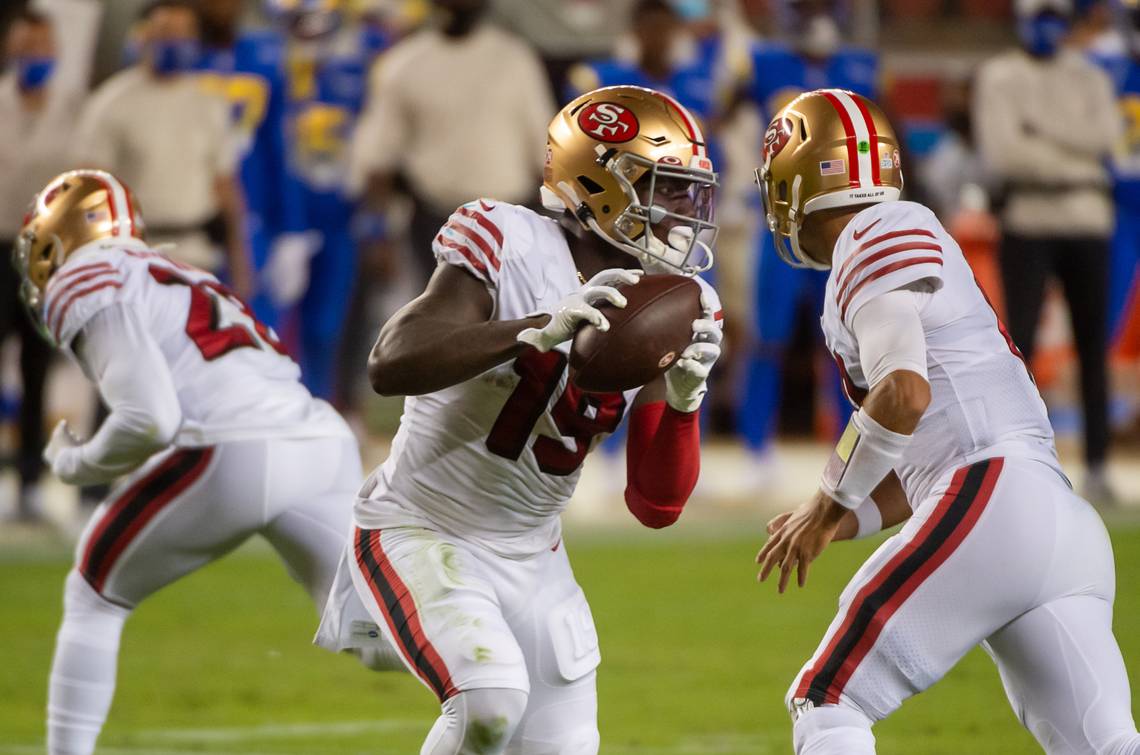
Wide Receiver
I offer an in-depth breakdown of Deebo Samuel here.
Meanwhile, Brandon Aiyuk offers tantalizing upside. The first round pick missed a few games, but had a stretch from Weeks 7-15 where he ended with over 17 fantasy points in all six games played. On the whole, the rookie averaged 15.4 (No. 16) Fantasy Points Per Game as the 49ers used him creatively, getting him carries and giving him 14 (No. 18) Red Zone Targets.

The efficiency metrics are nothing to write home about, but the hope is that Aiyuk can work downfield more than he did in 2020. With Samuel dominating the short area of the passing attack, Aiyuk can hopefully translate his college success as a downfield playmaker to the NFL. Don’t let his 9.0 (No. 72) Average Target Distance in 2020 fool you, it was probably more about the quarterback play than anything. Aiyuk posted an 18.3 (87th-percentile) College YPR average and I would expect him to start receiving more looks in that area of the field in 2021. I’d love to scoop him up anywhere I can.
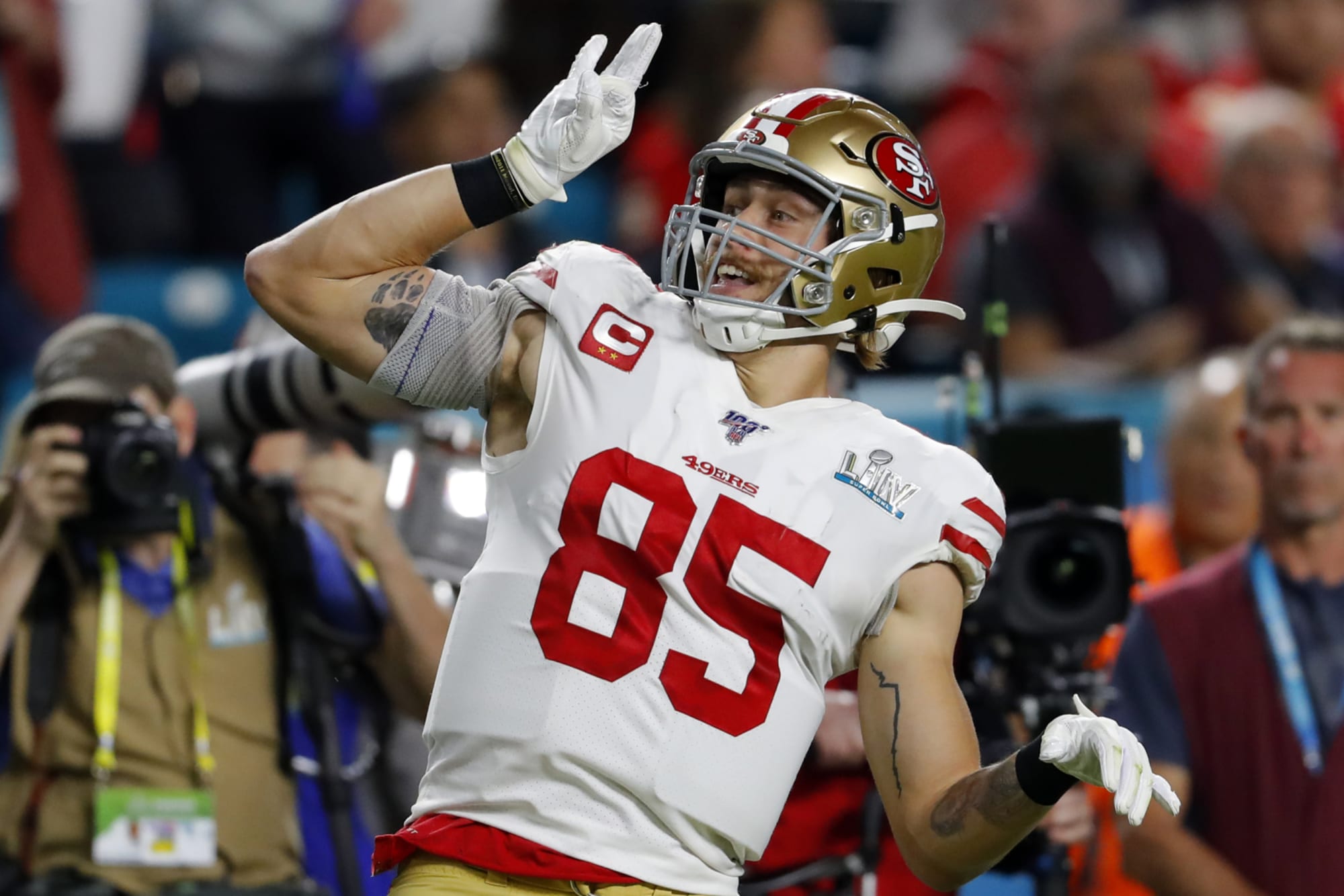
Tight End
George Kittle is a beast. While 2020 was an injured-plagued nightmare, don’t forget Week 4 against Philly where he went for 15/183/1. He’s going to be fine in 2021. He’s still only 27 and is an elite athlete. There’s likely a dip in value, so don’t hesitate to acquire him as you’re able.
Recap: Wait and see on quarterback. Ignore the runners. Grab Brandon Aiyuk, Deebo Samuel, and George Kittle.
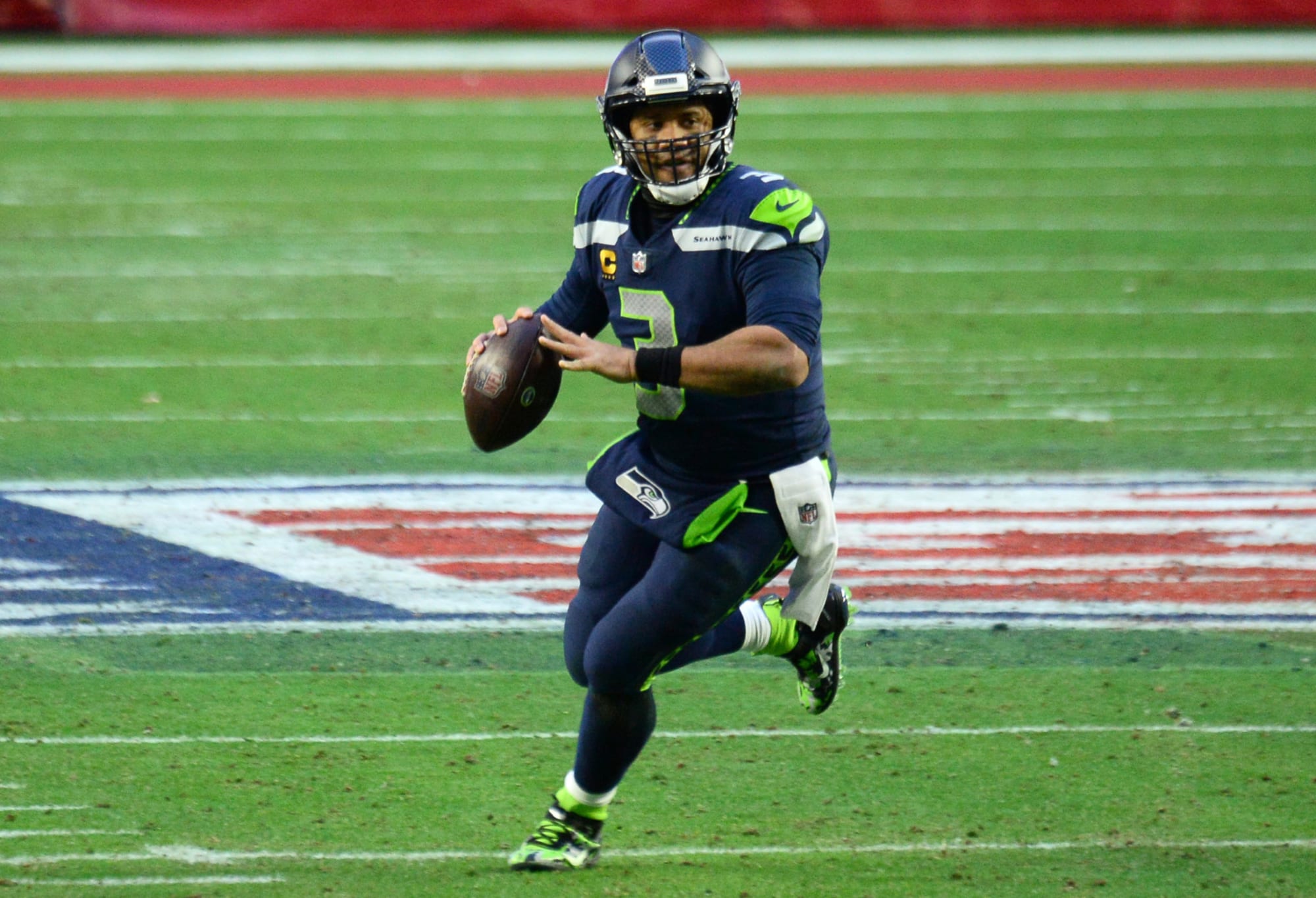
Seattle Seahawks
The start to the Seahawks season offensively was the stuff of dreams. Russell Wilson was cooking, and through the first eight games, they scored less than 30 points once. But the dream died in the second half of the season. The passing attack fell off as Russ and company failed to hit 300 passing yards in any of the final eight games. The tale of two halves makes for tough analysis of what 2021 may bring, but let’s take a look.
Quarterback
There is much about the 2020 season that should be cause for celebration. Wilson tallied 558 (No. 7) attempts, which was a career high. He was slinging it all over the yard, ending with 65 (No. 8) Deep Ball Attempts and 4,569 (No. 6) Air Yards. He also threw for a career-high 40 (No. 2) touchdowns. Russ was excellent, notching 33 (No. 5) Money Throws and a 7.8 (No. 4) Accuracy Rating as he put the ball on his receivers all year. Add in his solid rushing ability, accumulating 513 (No. 4) rushing yards.
Realistically, his touchdowns will come down, but Russ is an excellent passer, who can make plays with his legs. If his value has diminished because of a lackluster second half of the season, I’d happily acquire him. His upside is still astronomical if the Seahawks keep the passing volume up, and even if they don’t, Wilson has put together great seasons thanks to his consistently high efficiency.
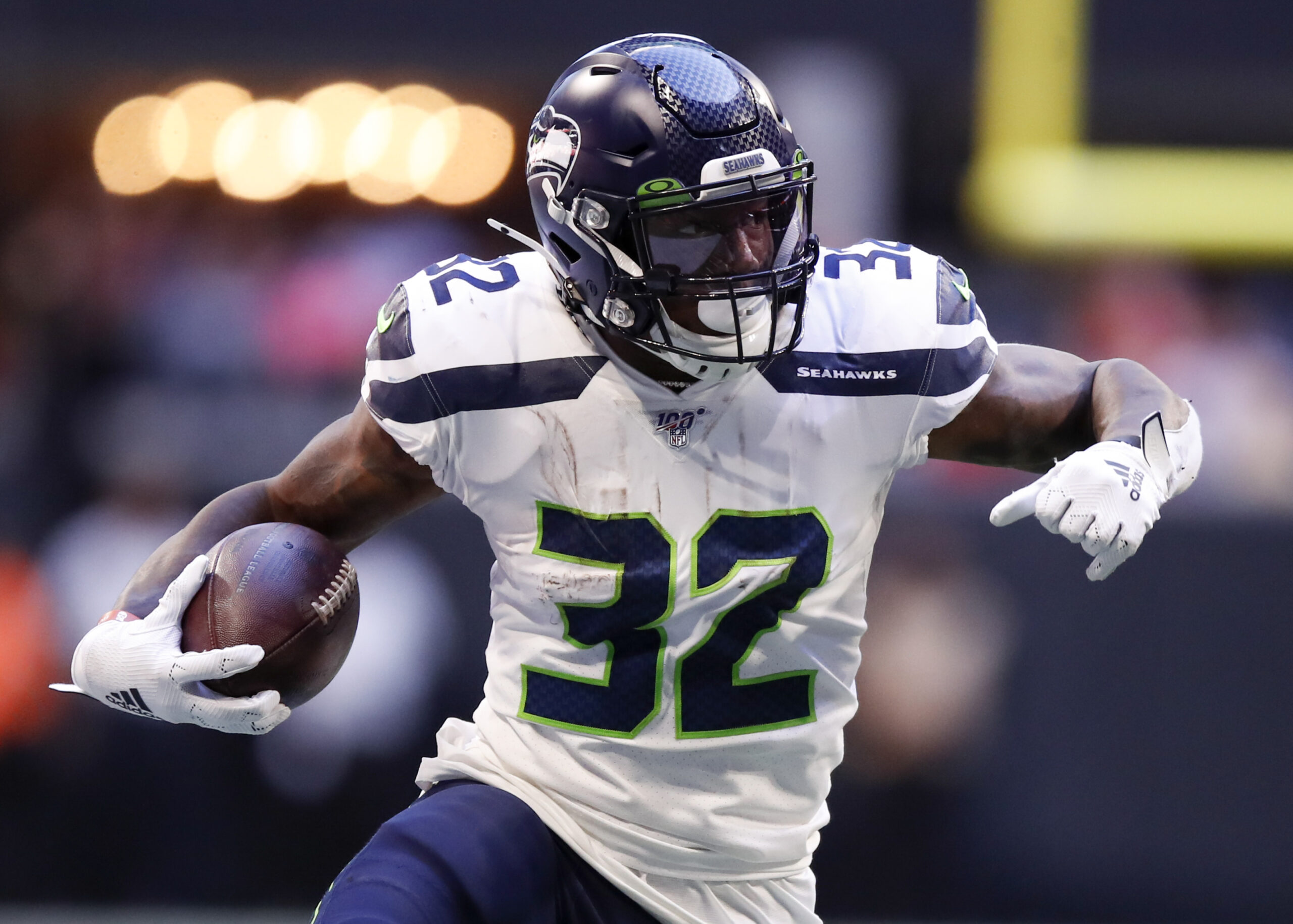
Running Back
It’s not happening for Rashaad Penny. He can’t stay healthy and hasn’t been that good when given the chance. A guy with first-round capital that can’t supplant Chris Carson isn’t a guy I’m banking on to score fantasy points.
Carson, on the other hand, is back for another two seasons in Seattle. He isn’t the most talented back in the world, but you don’t need him to be. He seems locked in as the RB1 in Seattle, and even if he cedes some more to Penny or whoever else is back there, he reliably produces.

Last year saw an encouraging trend in Carson’s receiving production. He had an 11.5-percent (No. 16) Target Share and ended with a 7.8 (No. 11) yards per reception average. With passable receiving prowess, he was able to take advantage of a a 91.3 (No. 9) Run Blocking Efficiency mark and tally a +30.3 (No. 2) Production Premium. Overall, gamers had to be pleased with the 15.7 (No. 11) Fantasy Points Per Game that he provided. Carson isn’t amazing, but no one expects him to be. He’s solid, and as options get skinny for the running back position, he should return plenty of value for the next two seasons.

Wide Receiver
D.K. Metcalf is a freak of nature. Too big. Too Fast. He’s a stud. Too late if you don’t already have him.
Tyler Lockett is where things get interesting in Seattle. There is no one at Lockett’s heels, so he should still produce in 2021, but he could be a player who isn’t as safe as he seems. All it would take is one first or second day rookie to start making Lockett owners sweat.
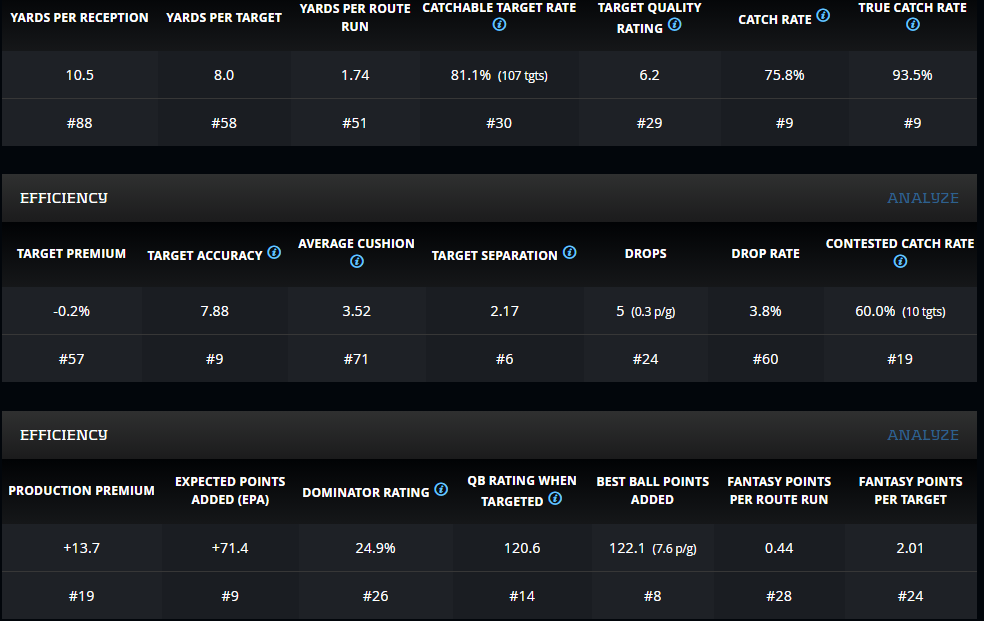
Lockett is a picture of volatility, going over 30.0 fantasy points three times (including 53.0 points in Week 7), but also dipped under 10.0 fantasy points seven times, resulting in a 13.6 (No. 1) Weekly Volatility score. Over the past few seasons, Lockett’s YPR has been trending in the wrong direction. He went from 16.9 YPR in 2018 to 10.5 YPR this past season. With Metcalf’s emergence, Lockett has turned into a Cooper Kupp-esque receiver. He notched 492 (No. 8) slot snaps and had a 9.7 (No. 63) Average Target Distance. He certainly helped teams in PPR leagues, but really his production was buoyed by 10 (No. 7) touchdowns, which will likely regress with Rusell Wilson’s TD Rate.
Entering into his age 29 season, I think Lockett’s best days are behind him. Until the Seahawks add another receiver, he will produce, but I’d be extremely nervous holding him. All it takes is one rookie or one free agent signing and his stock could be torpedoed.

Tight End
It’s hard to say for sure, but I think Gerald Everett will be the starter. Will Dissly is still there, but he isn’t terribly exciting. And so Everett has a golden opportunity to utilize his excellent athleticism and take hold of a starting job, something he could never quite do in LA.
Entering his fifth season, the South Alabama product is coming off career highs in catches (41) and receiving yards (417). He played his way into a timeshare with Tyler Higbee and the hope is that he can fend off Dissly here. Without a clear-cut WR3, Everett could certainly pop and makes an obvious tight end target in the later rounds. While he’s far from a sure thing, you can do worse looking for a high ceiling guy.
Recap: Keep riding Russell Wilson and D.K. Metcalf. Chris Carson coming back makes him a nice producer for at least 2021 and likely 2022. Grab Gerald Everett as long as he isn’t too expensive. as long as he isn’t too expensive.
Follow Daniel Jolly on Twitter @DanForADay
